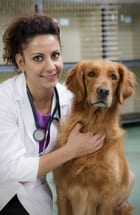Cruciate Ligament Injury and Repair
 The cruciate ligaments are ligaments that cross, or cruciate, the knee, joining the femur and the tibia, and are prone to injury. Such damage is common in dogs, but rarely occurs in cats.
The cruciate ligaments are ligaments that cross, or cruciate, the knee, joining the femur and the tibia, and are prone to injury. Such damage is common in dogs, but rarely occurs in cats.
The knee is a complex and relatively unstable joint. The cruciate ligaments, both anterior and posterior, help to maintain the knee's stability during a wide range of motion, letting it work as a hinge, but restricting its side to side movement. When these ligaments are torn or ruptured, the animal becomes unstable and possibly lame, and eventually, particularly if the condition is not treated properly, arthritis sets in.
Reasons for Cruciate Ligament Injury
Extremely athletic dogs that overexert themselves through activities like roughhousing or jumping off docks, sometimes suffer cruciate ligament injuries, but this accounts for only a small number of such problems.
Usually, the injury, although it may appear to occur suddenly, has been coming on for some time. The inflammation, previously thought to result from the precipitating incident, is now viewed as a possible cause, since an animal that suffers a cruciate tear in one knee is much more likely to suffer a similar injury in the other knee.
Risk Factors for Cruciate Ligament Injury
While the precise causes of this problem are not known, certain breeds of dogs are at greater risk of developing the problem. These breeds include: rottweiller, cocker spaniel, Labrador retriever, German shepherd, toy and miniature poodle. Other risk factors may include:
- Being over 4 years old
- Being neutered
- Having an underlying auto-immune disorder
- Having joint disease or inflammation
- Having received prolonged corticosteroid treatment
The reason for the connection between ligament damage and corticosteroid medication may be the result of the weight gain the medication causes, rather than an effect of the medication itself.
While less common in cats, cruciate ligament injury may occur if the animal severely twists its knee. Once the ligament is torn, the bones of the knee do not move normally and pain results. If the condition is severe, the cat may not be able to bear its own weight and may collapse if it attempts to stand.
Diagnosis of Cruciate Ligament Injury
Most often, the veterinarian is able to diagnose cruciate ligament damage through physical examination. Two physical tests are usually performed, called the positive cranial drawer test and the positive tibial compression test. These tests may require sedation of the animal, especially if it is large.
X-rays are administered to confirm the diagnosis of a cruciate injury and to eliminate other possible causes of the symptoms, such as a fracture or rheumatoid arthritis. If the doctor suspects another underlying disease, a specimen of joint fluid may be obtained for laboratory analysis.
Treatment of Cruciate Ligament Injury
 There are two types of treatment available, depending on the extent and duration of the ligament injury.
There are two types of treatment available, depending on the extent and duration of the ligament injury.
Non-surgical Treatments
In dogs weighing less than 15 pounds and in cats, non-surgical treatments may help animals to return to normal functioning. These include physical therapy, restricting the animal's exercise and administering anti-inflammatory medications. In many cases, treatment also includes restricting the animal's diet in order to promote weight loss.
Surgical Treatments
Typically, a cruciate ligament injury in a larger animal is treated with surgery to repair the tear. There are several types of surgical procedures performed, using either the patient's own tissue, material from tissue banks, or artificial grafts to make the repair. There is also a procedure in which a cut is made in the bone and a plate inserted to stabilize the knee.
Usually, animals will require 3 to 6 months of rehabilitation after surgery, depending on which surgery was performed and on their weight and overall health. Although they may recover with some physical limitations, may tire more easily after exercise, or may require occasional pain medication, they should be able to resume normal, happy lives.